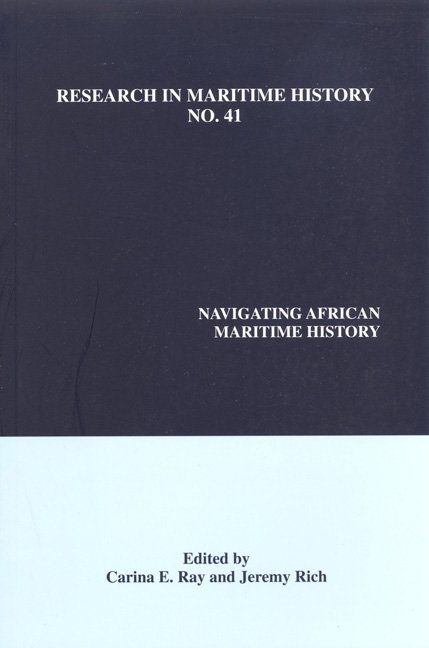Book contents
- Frontmatter
- Table of Contents
- About the Editors
- Contributors' Notes
- “Introduction: Charted Routes and New Directions in the Study of Africa's Maritime History”
- “Austronesian Mariners and Early Trans-Indian Ocean Crossings”
- “Eight Hens per Man per Day: Shipwreck Survivors and Pastoral Abundance in Southern Africa”
- “State Control and Regulation of Commerce on the Waterways and Coast of Senegambia, ca. 1500-1800”
- “Swimming, Surfing and Underwater Diving in Early Modern Atlantic Africa and the African Diaspora”
- “Rough Sailing: Risks and Opportunities for Immigrant African Maritime Workers in Gabon, ca. 1860-1914”
- “Desertion, Dereliction and Destitution: The Travails of Stranded West African Seamen in the United Kingdom, ca. 1921-1934”
- “‘The White Wife Problem:’ Sex, Race and the Contested Politics of Repatriation to Interwar British West Africa”
- “Sailing Beyond Apartheid: The Social and Political Impact of Seafaring on Coloured South African Sailors”
“Austronesian Mariners and Early Trans-Indian Ocean Crossings”
- Frontmatter
- Table of Contents
- About the Editors
- Contributors' Notes
- “Introduction: Charted Routes and New Directions in the Study of Africa's Maritime History”
- “Austronesian Mariners and Early Trans-Indian Ocean Crossings”
- “Eight Hens per Man per Day: Shipwreck Survivors and Pastoral Abundance in Southern Africa”
- “State Control and Regulation of Commerce on the Waterways and Coast of Senegambia, ca. 1500-1800”
- “Swimming, Surfing and Underwater Diving in Early Modern Atlantic Africa and the African Diaspora”
- “Rough Sailing: Risks and Opportunities for Immigrant African Maritime Workers in Gabon, ca. 1860-1914”
- “Desertion, Dereliction and Destitution: The Travails of Stranded West African Seamen in the United Kingdom, ca. 1921-1934”
- “‘The White Wife Problem:’ Sex, Race and the Contested Politics of Repatriation to Interwar British West Africa”
- “Sailing Beyond Apartheid: The Social and Political Impact of Seafaring on Coloured South African Sailors”
Summary
Introduction
It has long been known that Austronesia – often traditionally termed “Malay” or “Malayo-Polynesia” – made a major contribution in the peopling of Madagascar, which lies in the western Indian Ocean between 12° and 25° South, separated from mainland Africa by 350 kilometres (km.) of ocean (the Mozambique Channel). The world's fourth largest island (587,041 km.), Madagascar currently has a population of approximately twenty million, all of whom speak Malagasy, an Austronesian language that the majority of scholars believe is most closely related to Manjaan, a language spoken in southeast Borneo. Many aspects of their material culture are also clearly Southeast Asian in origin, from traditional boat-building and iron-production techniques to rectangular houses and riziculture (rice growing). In the early 1990s, however, the first definitive evidence emerged that the Malagasy share a genetically mixed origin; apart from genetically distinct minority groups, notably of Indian and Middle Eastern descent, all Malagasy possess an ancient African Bantu and Austronesian genetic input.
This in turn has helped to fuel the debate over the timing, route and cause of the Austronesian migration across the Indian Ocean. The conventional view, forged by the father-and-son team of Alfred and Guillaume Grandidier, was that such voyages were, at least initially, undertaken in a spirit of adventure, and that as early as 3000 BCE Austronesian sailors sailed in their outrigger canoes west across the Indian Ocean directly to Madagascar – a distance of about 4800 km. Indian Ocean currents and winds are favourable to the proposed trajectory in the equatorial zone, as was illustrated when in August 1883, three months after it erupted, pumice from Krakatoa in Java washed ashore on the Madagascar's east coast.
Most historians of Madagascar currently reject the Grandidier thesis. Instead, following Gabriel Ferrand and Otto Dahl, they argue that the Austronesian component of the proto-Malagasy sailed via the northern rim of the Indian Ocean, eventually reaching and settling in East Africa. There they intermarried with Africans prior to migrating to Madagascar via the Comoro Islands sometime between the first century BCE and the fourth century CE, although separate and distinct African migration to the island may also have occurred at approximately the same period.
- Type
- Chapter
- Information
- Navigating African Maritime History , pp. 19 - 32Publisher: Liverpool University PressPrint publication year: 2009



